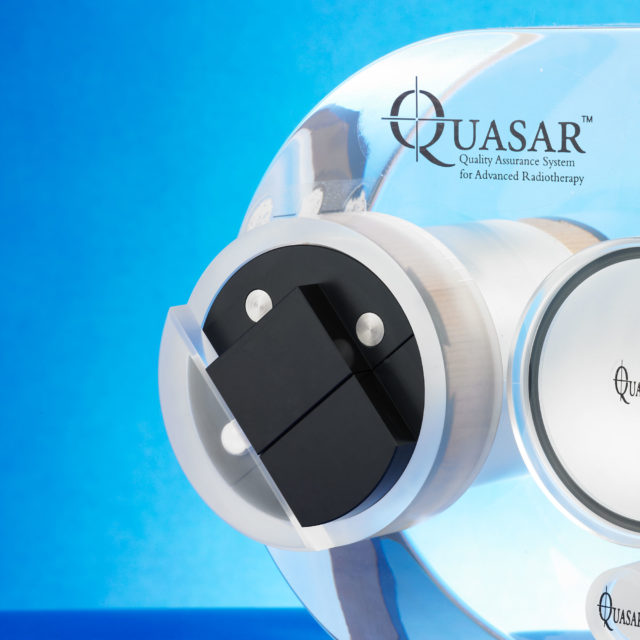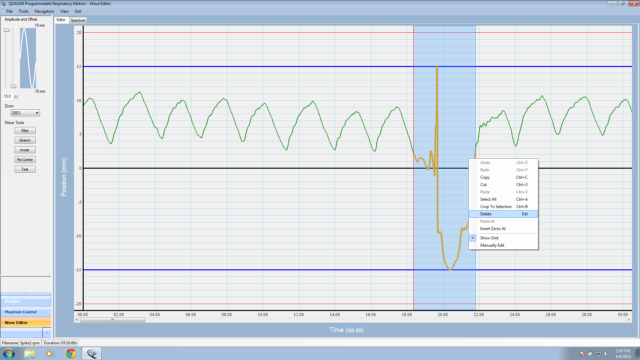












QUASAR™ Respiratory Motion Phantom (pRESP)
Radiation Therapy technologies, such as IGRT, SGRT and respiratory gating, have led to significant advances in patient treatment. The QUASAR™ Respiratory Motion Phantom (pRESP) is a programmable breathing and tumour motion simulator for end-to-end quality assurance on motion-guided radiation therapy systems including CT, LINAC, and PET.
The QUASAR Respiratory Motion Phantom has been adopted by Medical Physicists around the world. A balance of simple design and comprehensive testing capabilities have solidified its reputation as an industry-leading tool for respiratory motion management.

Integrate your motion QA with the leaders in SGRT.
The QUASAR Respiratory Motion Phantom features a vertical chest-wall platform that is compatible with a number of Surface Guided Radiation Therapy Systems (SGRT), such as: Vision RT, C-RAD, Brainlab, and Varian Identify. Easily import patient-specific waveforms from various motion capture and waveform generating sources. Compatible with the following file formats: VXP, .CSV, .TXT, .DCM, .LOG, .DAF, .IMA
-
Specifications
- Body Oval; 30 cm wide, 20 cm high, 12 cm long, acrylic, 7 kg
- Drive unit; 20 cm long, 15 cm wide, 12 cm high, 5 kg, acrylic in field of view
- Respiratory Phantom mass; approximately 14 kg with Body Oval and all options
- Two openings in Body Oval for drive unit and moving Insert, 8 cm diameter
- Chest Wall Platform; 13 cm diameter, carries up to 1 kg
- Power Supply; Input, 100–240VAC, 47–63 Hz, International power cords available on request. Output, 24VDC, 2.1 A, 50 W. Approvals; CE, cUL
- User’s Guide and cardboard container for on-site storage and handling are included with the stand-alone and accessory versions
- Optional heavy-duty shipping case replaces cardboard container
-
Optional Accessories
- 500-3330: Rotation Stage
- 500-2003: Heavy-duty Shipping Case 8 kg
-
Minimum Technical Requirements
- Operating System: Windows 7 SP1, 8.1 or 10
- Ports: 1 Ethernet
-
100-1011: QUASAR™ Respiratory Motion Phantom
- 1-Phantom
- 1-Software License
-
Optional Inserts
- 500-3305: Acrylic Insert
- 500-3311: Cedar Insert with Solid Tumour
- 500-3312: Cedar Insert with Solid Tumour – Drilled
- 500-3313: Cedar Lung Tumour Insert (Split)
- 500-3314: Hollow Insert with Screw Cap
- 500-3315: Film Cassette Insert
- 500-3317: 4D CT Imaging Insert
- 500-3318: PET/CT Insert
- 500-3322: MP Insert Adapter
- 500-3331: Offset Cedar Insert with Solid Tumour
- 500-3332: Offset Cedar Insert with Solid Tumour - Drilled
- 500-3333: Offset Cedar Lung Tumour Insert (Split)
- 500-3395: Cedar Ion Chamber Holder
Features
Simplicity
Modus QA has developed an easy to use phantom with comprehensive testing capabilities for demanding motion protocols in modern radiation therapy departments. From its manual operation mode to its magnetic insert connection, the pResp was designed with the end user in mind, providing an intuitive motion-management QA tool.
Motion Control Options
Choose easy operation with local manual control at the motor or advanced programmable software driven control. The pRESP can produce simple translational motion or create complex 3D patterns with the QUASAR™ Respiratory Motion Rotation Stage (ITEM# 500-3330). With playback of motion waveforms, complexity is elevated to test the limits of your motion management systems.
Motion Precision
The QUASAR™ Respiratory Motion Phantom exhibits detailed sensitivity when replicating captured or created waveforms. A highly responsive motor repositions the translation stage every 10 mS (100x per second) providing real-life breathing replication. Waveforms from zero to 60BPM are replicated with ease, testing a large range of clinical protocols.
Versatility
Supporting a comprehensive library of interchangeable inserts, the pRESP is a flexible tool able to test techniques on CT, LINAC, and PET platforms. Perform end-to-end validation using a variety of imaging and dosimetry inserts including ion chamber holders, film cassettes and OSLD holders.
Software
Included with the QUASAR™ Respiratory Motion Phantom is an intuitive programmable respiratory motion QA software. This locally installed package enables the control of the phantom’s motion and customization of supplied and imported motion waveforms. An incorporated Deep Inspiration Breath Hold Function increases workflow efficiency for users to test DIBH protocols.


Complex Motion Control Options
The QUASAR Respiratory Motion Phantom offers full control of your phantom’s motion profile. Our Respiratory Motion QA Software offers multiple operation modes to increase utility. From adjustable sinusoidal waveforms and simple test patterns to accurate playback of complex 3D waveforms, the pRESP offers the flexibility to choose your motion complexity for your required testing sequence.
Customizable Waveforms
In addition to an extensive library of pre-loaded waveforms, the Respiratory Motion QA Software enables the import of acquired waveforms from a number of respiratory gating and motion tracking systems. The waveforms are completely customizable, improving the user experience when modifying waveform patterns to achieve the desired testing protocol.
Additional Resources
Effect of later target motion on image registration accuracy in CT-guided helical tomotherapy: A phantom study
MEDWIG J., GAEDE S., BATTISTA J.J., YARTSEV S., Effect of later target motion on image registration accuracy in CT-guided helical tomotherapy: A phantom study, Journal of Medical Imaging and Radiation Oncology 54 (2010) 280-286
Impact of motion velocity on four-dimensional target volumes: A phantom study
NAKAMURA M., NARITA Y., SAWADA A., MATSUGI K., NAKATA M., MATSUO Y., MIZOWAKI T., HIRAOKA M., Impact of motion velocity on four-dimensional target volumes: A phantom study, Med. Phys. 36 (5), May 2009, 1610-1617
Imaging and radiation delivery in helical tomotherapy: Phantom study of a moving target
GALLAGHER, C., YARTSEV, S., VAN DYK, J., Imaging and radiation delivery in helical tomotherapy: Phantom study of a moving target, Poster presented at the 54th Canadian Organization of Medical Physicists (COMP) Annual Meeting, June 25-28, 2008, Quebec, QC, Canada
The Effect of Target Motion on Megavoltage CT Registration
MEDWIG, J., YARTSEV, S., VAN DYK, J., The Effect of Target Motion on Megavoltage CT Registration, Poster presented at Research Day 2008, Lawson Health Research Institute, March 26, 2008, London, ON, Canada
The management of respiratory motion in radiation oncology report of AAPM Task Group 76
KEALL P.J., et.al., The management of respiratory motion in radiation oncology report of AAPM Task Group 76, Med. Phys. 33 (2006) 3874 – 3900.
Dosimetric Considerations in Radiation Therapy of Coin Lesions of the Lung
YORKE E., HARISIADIS L., WESSELS B., AGHDAM H., ALTEMUS R., Dosimetric Considerations in Radiation Therapy of Coin Lesions of the Lung, Int. J. Radiation Oncology Biol. Phys., Vol.34, No. 2, pp. 481–487, 1996.
Monte Carlo dose calculation of segmental IMRT delivery to a moving phantom using dynamic MLC and gating log files
OLIVER M., STARUCH R., GLADWISH A., CRAIG J., CHEN J., WONG E., Monte Carlo dose calculation of segmental IMRT delivery to a moving phantom using dynamic MLC and gating log files, Phys. Med. Biol. 53 (2008) N187–N196.
Motion in radiotherapy: photon therapy
KORREMAN SS., Motion in radiotherapy: photon therapy, Phys Med Biol. 2012 Nov 20;57(23):R161-R191.

